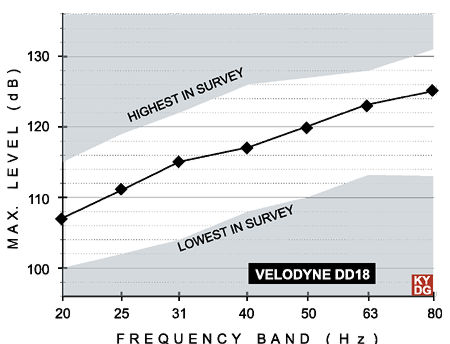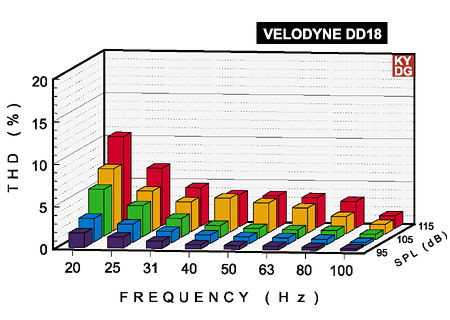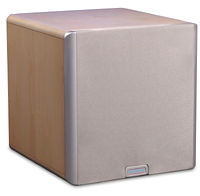Way Down Deep III Velodyne DD18
With only slight exaggeration, Velodyne's DD18 could be called the first subwoofer with a college education. A leading name dating back to home theater's beginnings two decades ago, the Silicon Valley firm recently launched its new flagship series, Digital Drive (DD), to replace the long-established High Gain Servo (HGS) line.
Compared to the HGS18, the DD18 boasts a more robust driver, a noticeably stouter and better-put-together cabinet, and a slight but welcome styling upgrade. The new model gets its smarts from several factors: a sensor in the moving assembly that enables a fast-acting circuit to correct any unwanted cone movement (the servo system); an internal digital crossover and eight-band parametric digital equalizer; more custom internal circuitry to generate test signals; a supplied test microphone; and a video output and remote control to help the user or installer display and navigate the settings and options. Velodyne also thought far enough ahead to include the AV and mike cables the user will need to get his or her room filled with clean, solid bass in relatively short order.
You view the DD18's in-room response on your TV monitor and use the remote to flatten out the peaks. (Trying to fill in the valleys is risky for reasons beyond our subject here—suffice it to say it may easily require so much boost that you will overload the subwoofer.) The EQ is fully parametric, meaning the user has control over the frequency, the bandwidth (or Q), and the amount of boost/cut, up to maxima of 6dB boost and 12dB cut. Those with little interest in adjusting virtual sliders to get the smoothest frequency response will be interested to know that Velodyne is working on an automated EQ process for the DD series. To update a sub to include these and other advanced features, owners of any Digital Drive model will simply download the current version of the software to their units from Velodyne's website.
EQ settings can be saved as presets and later activated by the remote handset or a Crestron- or AMX-type control system. The settings can be invoked for different program material, listening positions, or sonic preferences. On Velodyne's advice, I used one of their four factory presets, Jazz/Classical, for my testing, as it offers the lowest distortion and flattest response deepest into the bass. (The other factory presets are Action Adventure, Movies, and Rock/Pop.) Because I was outdoors, the all-too-common response problems caused by reflections from walls and ceiling couldn't occur, so the DD18's sophisticated internal equalizer went unused. [A review of one of the smaller DD subs is underway, and will include more details on Velodyne's equalization feature.—Ed.]
Measurements
Frequency response at 80dB (Fig.14): 20–100Hz, +/-3.1dB; –7.4dB at 18Hz.

Fig.14: Frequency Response vs. Output
Frequency response at higher levels (Fig.14): The bass response remained intact up to and including 105dB, but the deep bass flagged at higher playback levels. At 110dB, the response softened below about 30Hz, requiring a 10.5dB-wide window to fit the full 20–100Hz trace; at 115dB, the sag began at around 40Hz.
Power Compression (Fig.15): Virtually no compression is visible up to a level of 110dB.

Fig.15: Power Compression
Dynamic range (Fig.16): Linkwitz shaped tone bursts showed the Velodyne to offer higher-than-average peak levels before audible distortion set in.

Fig.16: Shaped Tone-burst Peak Output
Total harmonic distortion (Fig.17): Extremely low, barely reaching 10% under the most taxing conditions (20Hz, 115dB), and generally well under 5%.

Fig.17: Total Harmonic Distortion vs. Frequency & Level
Listening
If the electronically sophisticated DD18 objected to being exercised by the lowbrow special effects of "Jurassic Lunch," it kept mum about it—no raspy distortion, no cabinet squeak, no rattle of internal assemblies, no cone cry, nothing but a deep, clean pulse when the T. rex's final clomp came along at 1:02 (Fig.A5). True, the ground didn't shake, not literally, but this clomp sounded as if it came from a big enough critter to steer clear of.
 The depth-charge blasts in U-571 were fuzz-, crackle-, and thwock-free, and teeth-rattlingly explosive, the sub-only peaks hitting 116dB (Fig.B5). The sense of being physically in the movie, as opposed to at the movies, continued with the next selection, the Gooding-at-the-guns scene starting at 1:36:45 in Pearl Harbor. As verified in the dark red ridge in the spectrogram, the DD18 mounted a forceful argument for the strong ridge of recorded energy centered around 30Hz (Fig.D5). The subjective effect was of a relentless, weighty throb, physical enough to pass for the sound of real antiaircraft guns letting loose at enemy airplanes, and clean enough not to betray the fact that it was the work of a relatively compact subwoofer working at the edge of its abilities.
The depth-charge blasts in U-571 were fuzz-, crackle-, and thwock-free, and teeth-rattlingly explosive, the sub-only peaks hitting 116dB (Fig.B5). The sense of being physically in the movie, as opposed to at the movies, continued with the next selection, the Gooding-at-the-guns scene starting at 1:36:45 in Pearl Harbor. As verified in the dark red ridge in the spectrogram, the DD18 mounted a forceful argument for the strong ridge of recorded energy centered around 30Hz (Fig.D5). The subjective effect was of a relentless, weighty throb, physical enough to pass for the sound of real antiaircraft guns letting loose at enemy airplanes, and clean enough not to betray the fact that it was the work of a relatively compact subwoofer working at the edge of its abilities.
The DD18 earned a qualified thumbs-up with Black Hawk Down (Fig.C5), where it at least hinted that there could be danger awaiting the young Marines as they scrambled out to the waiting choppers. A few other subs I've tested nabbed a bigger chunk of the 18Hz rumble, which set up a more palpable sense of foreboding in the audience, but those subs also claim a considerably bigger chunk of the user's floor space and bank account.
Those big, ripe bass-drum strokes in "March of the Exorcists," from the Casper soundtrack CD, sounded pristine up to a more than adequate 111.5dB. The Velodyne stumbled, if only slightly, on the Blue Crush selection, where a massive wall of water threatens to pulverize the little surfer girl. Some minor flutter/gurgle sounds intruded at C-weighted sub-only peaks of 106dB.
The chopper crash sequence, beginning at 1:51:03 in The Matrix, sounded solid and clean, but never rivaled the riveting effect I got from the larger Genelec and ServoDrive units. Alone among subs in its size class, the DD18 managed enough low-end heft and level, at low enough distortion, to create the stirring effect Tchaikovsky intended by the final cannon fusillade in his 1812 Overture.
The Bottom Line
Among the under-$5000 subs in the survey, Velodyne's DD18 led the pack, combining flat response, strong dynamics, and negligible distortion. In almost every way that matters, it represents a substantial improvement over the HGS18, itself considered a benchmark by nearly every subwoofer manufacturer I spoke with. Yet the DD18's most outstanding quality is its ability to be tailored to whatever acoustic environment it's put in. (I didn't have an acoustic environment to speak of.)
The truth is, only a small fraction of subwoofer owners are getting the bass quality they paid for. As I mentioned in the introduction to Part I, great bass is not only a product of the right subwoofer, it's also a product of the right process. That process must include (but is not limited to) careful adjustment of the subwoofer's response at the listening position (or a spatial average of several listening positions). The conventional adjustment routine typically requires: an outboard parametric equalizer or DSP platform (e.g., Symetrix Symnet or BSS Soundweb); sensitive test equipment; an operator who knows what to fix and what not to fix, and why; and a homeowner willing to pay for extra hardware and services.
Velodyne's new Digital Drive series pre-sents an alternative route that amounts to a shortcut to the finish line. Of course, a typical audio enthusiast will not be able to achieve quite the same "perfect tune" with the onboard EQ as an acoustician will with his/her standalone test gear and a day's worth of testing and tweaking. But that in no way diminishes the significance of Velodyne's achievement. The DD18 promises to bring better in-room bass performance to home theater enthusiasts who don't happen to have an acoustician standing by—and to many of those who do.
Specifications
Velodyne DD18 powered subwoofer in sealed cabinet of 1"-thick MDF
Driver: 18" Kevlar-reinforced cone with tandem voice coil, 24-lb magnet
Frequency response: 14–120Hz, +/-3dB
Inputs: LFE (XLR, RCA), L/R (RCA). Speaker-level (5-way binding posts)
Outputs: L/R (RCA)
Amplifier: 1250W RMS, 3000W peak
Highpass filter: 80Hz (fixed), 6dB/octave
Lowpass filter: adjustable in 1Hz increments, 15–199Hz; slope adjustable: 6, 12, 18, 24, 30, 36, 42, or 48dB/octave
Phase: adjustable in 15° increments, 0–180°; polarity adjustable (+/-)
Other: high-gain servo for reducing distortion; signal generator/video sweep output; test microphone & mike cable included; Digital Drive for electronic management of in-room response
Finishes: gloss black; maple or cherry veneer
Dimensions: 23" {x} 21.25" {x} 19.25" (H{x}W{x}D)
Weight: 120 lbs
Price: $4999
Velodyne Acoustics
(408) 465-2800
www.velodyne.com





























































